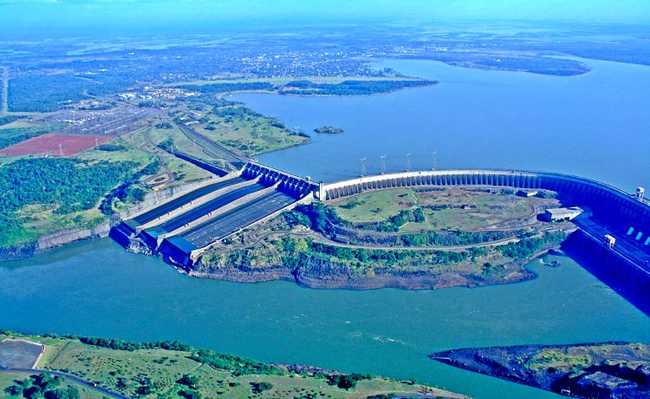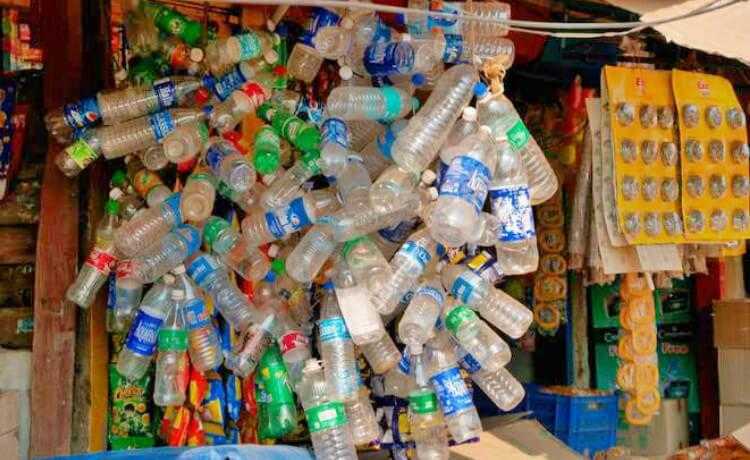What is hydropower?
Understand how hydropower transforms water energy into electricity, its advantages and disadvantages

Image: Itaipu Dam, Paraguay/Brazil by International Hydropower Association (IHA) is licensed under CC BY 2.0
What is hydraulic (hydroelectric) energy?
Hydroelectric energy is the use of kinetic energy contained in the flow of water bodies. Kinetic energy promotes the rotation of the turbine blades that make up the hydroelectric power plant system, to be later transformed into electrical energy by the system's generator.
What is a hydroelectric plant (or hydroelectric plant)?
A hydroelectric plant is a set of works and equipment used to produce electricity from the use of the hydraulic potential of a river. The hydraulic potential is given by the hydraulic flow and the concentration of the existing unevenness along the course of the river. The gaps can be natural (waterfalls) or built in the form of dams or through the river's diversion from its natural bed to the formation of reservoirs. There are two types of reservoirs: accumulation and run-of-river reservoirs. The accumulations are usually formed in the headwaters of rivers, in places where there are high waterfalls and consist of large reservoirs with a large accumulation of water. Run-of-river reservoirs take advantage of the speed of river water to generate electricity, thus generating minimal or no water accumulation.
The plants, in turn, are classified according to the following factors: height of the waterfall, flow, installed capacity or power, type of turbine used in the system, dam and reservoir. The construction site gives the height of fall and the flow, and these two factors determine the capacity or installed power of a hydroelectric plant. The installed capacity determines the type of turbine, dam and reservoir.
According to a report by the National Electric Energy Agency (Aneel), the National Reference Center for Small Hydroelectric Plants (Cerpch, from the Federal University of Itajubá – Unifei) defines the height of the waterfall as low (up to 15 meters), medium ( 15 to 150 meters) and high (greater than 150 meters). However, these measures are not consensual. The size of the plant also determines the size of the distribution network that will carry the generated electricity to consumers. The larger the plant, the greater its tendency to be far from urban centers. This requires the construction of large transmission lines that often cross states and cause energy losses.
How does a hydroelectric plant work?
For the production of hydroelectric energy it is necessary to have the integration of the river flow, the unevenness of the terrain (natural or not) and the amount of available water.
The system of a hydroelectric plant is composed of:
Dam
The purpose of the dam is to interrupt the river's natural cycle, creating a water reservoir. The reservoir has other functions in addition to storing water, such as creating a water gap, capturing water in an adequate volume for energy production and regulating the flow of rivers in periods of rain and drought.
Water collection (adduction) system
Composed of tunnels, channels and metallic conduits that carry water to the powerhouse.
Powerhouse
In this part of the system are the turbines connected to a generator. Turbine movement converts the kinetic energy of water movement into electrical energy through generators.
There are several types of turbine, being pelton, kaplan, francis and bulb the main ones. The most suitable turbine for each hydroelectric plant depends on the head and flow. An example: the bulb is used in run-of-river plants as it does not require the existence of reservoirs and is indicated for low falls and high flows.
escape channel
After passing through the turbines, the water is returned to the natural river bed through the tailrace.
The escape channel is located between the powerhouse and the river and its dimension depends on the size of the powerhouse and the river.
Spillway
The spillway allows water to flow out whenever the reservoir level exceeds the recommended limits. This normally occurs in periods of rain.
The spillway is opened when electricity production is impaired because the water level is above the ideal level; or to avoid overflowing and consequently flooding around the plant, which can happen in very rainy periods.
Social and environmental impacts caused by the implementation of hydroelectric plants
The first hydroelectric plant was built in the late 19th century on a stretch of Niagara Falls, between the United States and Canada, when coal was the main fuel and oil was not yet widely used. Prior to this, hydraulic energy was used only as mechanical energy.
Despite hydroelectric energy being a renewable energy source, the Aneel report points out that its participation in the world electric matrix is small and is becoming even smaller. The growing disinterest would be a result of the negative externalities arising from the implementation of such large enterprises.
A negative impact of the implementation of large hydroelectric projects is the change in the way of life of the populations that reside in the region, or in the surroundings of the place, where the plant will be implanted. It is also important to emphasize that these communities are often human groups identified as traditional populations (indigenous peoples, quilombolas, Amazonian riverside communities and others), whose survival depends on the use of resources from the place in which they live, and who have links with the territory of cultural order.
Is hydroelectric power clean?
Despite being considered by many as a “clean” energy source because it is not associated with the burning of fossil fuels, hydroelectric power generation contributes to the emission of carbon dioxide and methane, two gases potentially causing global warming.
The emission of carbon dioxide (CO2) is due to the decomposition of trees that remain above the water level in the reservoirs, and the release of methane (CH4) occurs through the decomposition of organic matter present at the bottom of the reservoir. As the water column increases, the concentration of methane (CH4) also increases. When water hits the plant's turbines, the difference in pressure causes the methane to be released into the atmosphere. Methane is also released into the water's path through the plant's spillway, when, in addition to the change in pressure and temperature, the water is sprayed in droplets.
CO2 is released by the decay of dead trees above water. Unlike methane, only part of the CO2 emitted is considered impactful, as a large part of the CO2 is canceled through absorptions that occur in the reservoir. As methane is not incorporated into photosynthesis processes (although it can be slowly transformed into carbon dioxide) it is considered to have more impact on the greenhouse effect, in this case.
The Balcar Project (Greenhouse Gas Emissions from Reservoirs of Hydroelectric Power Plants) was created to investigate the contribution of artificial reservoirs to the intensification of the greenhouse effect through the emission of carbon dioxide and methane. The first studies of the project were carried out in the 1990s, in reservoirs in the Amazon region: Balbina, Tucuruí and Samuel. The Amazon region was focused in the study because it is characterized by massive vegetation cover, and therefore, greater potential for emission of gases by decomposition of organic matter. Later, in the late 1990s, the project also included Miranda, Três Marias, Segredo, Xingo and Barra Bonita.
According to the article that Dr. Philip M. Fearnside, from the Amazon Research Institute, published on gas emissions at the Tucuruí Plant, in 1990, the plant's greenhouse gas emissions (CO2 and CH4) varied between 7 million and 10 million tons that year. The author makes a comparison with the city of São Paulo, which emitted 53 million tons of CO2 from fossil fuels in the same year. In other words, only Tucuruí would be responsible for emitting the equivalent of 13% to 18% of the emission of greenhouse gases in the city of São Paulo, a significant value for an energy source considered for a long time as “emission-free”. It was believed that, over time, organic matter would undergo complete decomposition and, as a result, would no longer emit these gases. However, studies by the Balcar group have shown that the gas production process is fed through the arrival of new organic materials brought in by rivers and rain.
Loss of plant and animal species
Especially in the Amazon region, which has high biodiversity, there is the inevitable death of flora organisms in the place where the reservoir is formed. As for animals, even if careful planning is done in an attempt to remove the organisms, it cannot be guaranteed that all the organisms that make up the ecosystem will be saved. Furthermore, damming imposes changes in the surrounding habitats.
soil loss
The soil in the flooded area will necessarily become unusable for other purposes. This becomes a central issue especially in predominantly flat regions, such as the Amazon region itself. Since the power of the plant is given by the relationship between the flow of the river and the unevenness of the land, if the land has a low unevenness, a greater amount of water must be stored, which implies an extensive reservoir area.
Changes to the hydraulic geometry of the river
Rivers tend to have a dynamic balance between discharge, average water velocity, sediment load and bed morphology. The construction of reservoirs affects this balance and, consequently, causes changes of a hydrological and sedimentary order, not only in the impoundment site, but also in the surrounding area and in the bed below the reservoir.
Nominal capacity x actual quantity produced
Another issue to be raised is that there is a difference between the nominal installed capacity and the actual amount of electricity produced by the plant. The amount of energy produced depends on the flow of the river.
Thus, it is useless to install a system with the potential to produce more energy than the river's flow can provide, as happened in the case of the Balbina hydroelectric plant, installed on the Uatumã River.
Firm power of the plant
Another important point to be taken into account is the plant's firm power concept. According to Aneel, the plant's firm power is the maximum continuous production of energy that could be obtained, based on the driest sequence recorded in the historical flow of the river in which it is installed. This issue tends to become increasingly central in the face of increasingly frequent and severe drought periods.
Hydroelectric power in Brazil
Brazil is the country with the greatest hydroelectric potential in the world. Thus, 70% of it is concentrated in the Amazon and Tocantins/Araguaia basins. The first large-scale Brazilian hydroelectric plant to be built was Paulo Afonso I, in 1949, in Bahia, with power equivalent to 180 MW. Currently, Paulo Afonso I is part of the Paulo Afonso hydroelectric complex, comprising a total of four plants.
balbine
The Balbina hydroelectric plant was built on the Uatumã River, in Amazonas. Balbina was built to supply Manaus' energy demand. The forecast was for the installation of 250 MW of capacity, through five generators, with powers of 50 MW each. However, the flow of the Uatumã River provides a much lower average annual energy production, something around 112.2 MW, of which only 64 MW can be considered as firm power. Considering that there is an approximate 2.5% loss during the transmission of electricity from the plant to the consumer center, only 109.4 MW (62.4 MW in firm power). Value much lower than the nominal capacity of 250 MW.
Itaipu
The Itaipu hydroelectric plant is considered the second largest plant in the world, with 14,000 MW of installed power, and is second only to Três Gorges, in China, with 18,200 MW. Built on the Paraná River and located on the border between Brazil and Paraguay, it is a binational plant, as it belongs to both countries. The energy generated by Itaipu that supplies Brazil corresponds to half of its total power (7,000 MW) which is equivalent to 16.8% of the energy consumed in Brazil, and the other half of the power is used by Paraguay and corresponds to 75% of Paraguayan energy consumption.
Tucuruí
The Tucuruí plant was built on the Tocantins River, in Pará, and has an installed capacity equivalent to 8,370 MW.
Belo Monte
The Belo Monte hydroelectric plant, located in the municipality of Altamira, southwest of Pará and inaugurated by President Dilma Roussef, was built on the Xingu River. The plant is the largest hydroelectric plant 100% nationally and the third largest in the world. With an installed capacity of 11,233.1 Megawatts (MW). This means enough load to serve 60 million people in 17 states, which represents about 40% of residential consumption throughout the country. The equivalent installed production capacity is 11 thousand MW, in other words, the largest plant in terms of installed capacity of the country, replacing the Tucuruí plant as the largest 100% national plant. Belo Monte is also the third largest hydroelectric power plant in the world, behind Três Gargantas and Itaipu, respectively.
Many issues revolve around the construction of the Belo Monte plant. Despite having an installed capacity of 11,000 MW, according to the Ministry of the Environment, the plant's firm power corresponds to 4,500 MW, that is, only 40% of the total power. As it is built in an Amazon region, Belo Monte has the potential to emit large concentrations of methane and carbon dioxide. All this without counting the great impact on the lives of traditional populations and the great impact on fauna and flora. Another factor is that its construction benefits mostly companies, not the population. Approximately 80% of the electricity is destined to companies in the Center-South of the country.
Applicability
Despite the negative social and environmental impacts mentioned, hydroelectric energy has advantages compared to non-renewable energy sources such as fossil fuels. Despite contributing to the emission of methane and sulfur dioxide, hydroelectric plants do not emit or release other types of toxic gases, such as those exhaled by thermoelectric plants - very harmful to the environment and human health.
However, the disadvantages of hydroelectric dams compared to other renewable energy sources such as solar and wind, which have reduced environmental impacts compared to the impacts caused by hydroelectric dams, are more evident. The problem is still the viability of new technologies. An alternative to reduce impacts related to the production of hydroelectric energy is the construction of small hydroelectric plants, which do not require the construction of large reservoirs.
- What is solar energy, advantages and disadvantages
- What is wind energy?
Furthermore, the dams have a useful life of around 30 years, which calls into question their long-term viability.
The study "Sustainable Hydropower in the 21st Century", conducted by Michigan State University, calls attention to the fact that large hydroelectric dams could become an even less sustainable source of energy in the face of climate change.
It is necessary to consider the true costs of hydroelectric energy, not only the economic and infrastructure costs, but also the social, environmental and cultural costs.










